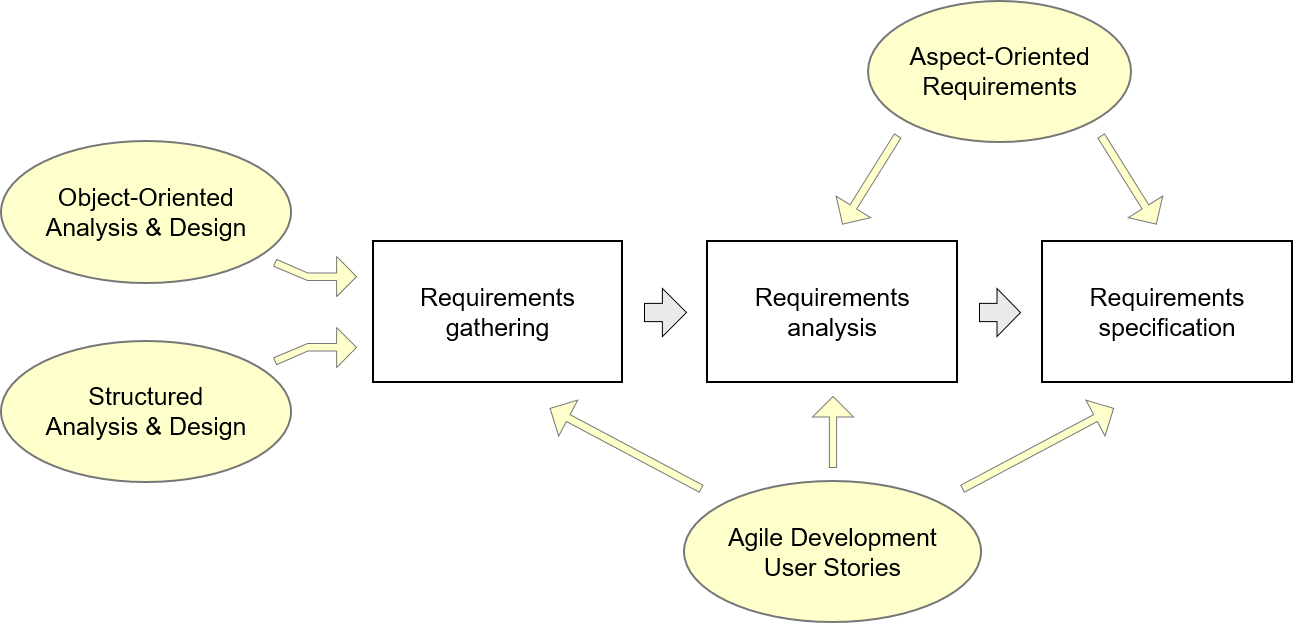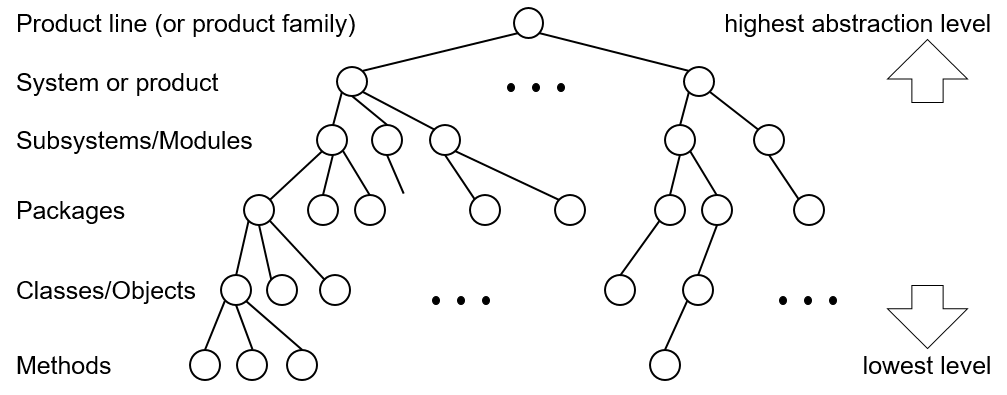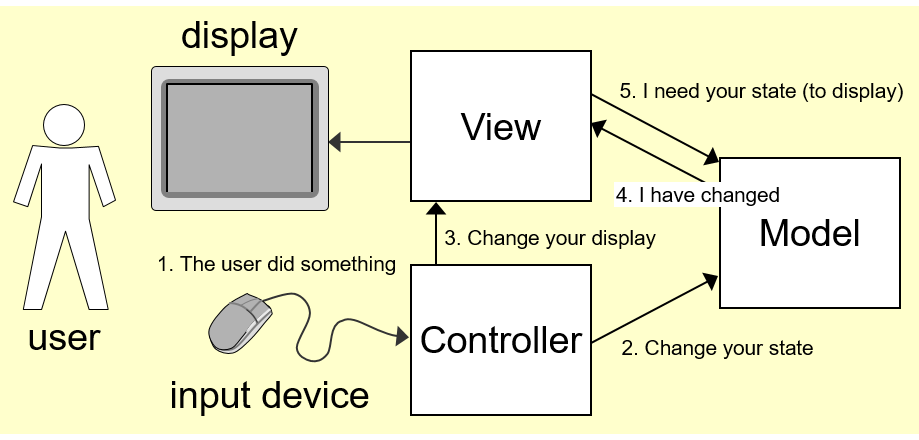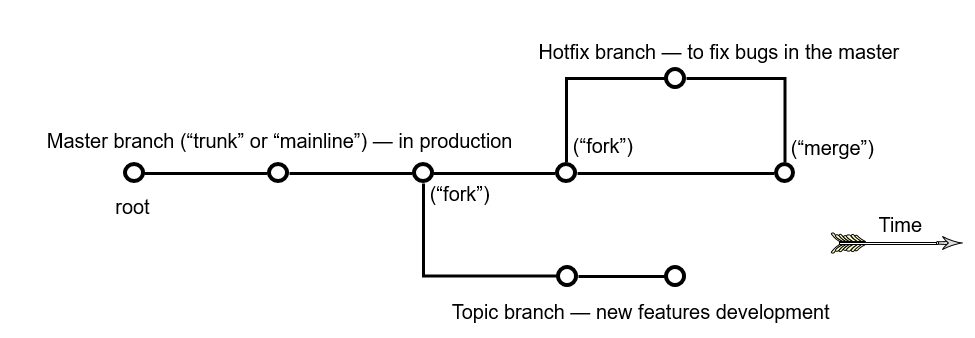Software Engineering
- Further details of the course are available at the Course webpage
Introduction
- Things that are complex are not always complicated.
- Complex means that it is composed of many simple components that are related to one another
- Complicated means that it is not well understood, or explained
-
First Law of Software Engineering - A software engineer should be willing to learn the problem domain(A problem cannot be solved without fully understanding it first)
- A software engineer’s task is to understand how the system needs to interact with the user or environment so that the customer’s requirement is met and design the software-to-be
-
The programmer’s task is to implement the software-to-be which is designed by the software engineer
- Second Law of Software Engineering - Software should be written for people first
Software Development Methods
- Method = work strategy - how the work gets done in the team
- Some development methods are:
- Waterfall - Unidirectional, finish this step before moving to the next
- Iterative & Incremental - Develop increment of functionality, repeat in a feedback loop
- Agile - User feedback is essential; feedback loops on several levels of granularity
Software Measurement
- What is a measure?
- Project(a developer’s work), for budgeting and scheduling
- Product, for quality assessment
Software Configuration Management
- Software Configuration Management(SCM) - the process of controlling the evolution of a software system
- Simplifies sharing code and other documents
- The ability to revert to an older version(“undo”)
- Coherently integrate contributions from team members(“merge”)
- Notify interested parties about new modifications(“reporting or watch or star”)
- Track software issues(e.g. bugs)
- Create an auditing trail(“archiving”)
- It simplifies collaboration and increases productivity
Definitions
- Software Configuration - a collection of work products created during a project lifetime
- Software Configuration Item(SCI) - any piece of knowledge created by a person(developer or consumer)
- A snapshot of a software configuration or a configuration item represents the version of that item at a specific time
- Commit - refers to submitting a software configuration to the project database
- Build - A version of a program code, and a process by which program code is converted into a stand alone form that can run on a computer
Repository vs Workspace
- A workspace is on your(the developers) computer where the code is created.
- The repository is a project database which is shared with all members of your project group
- A commit or push send codes from the workspace to the repository
- A retrieve or pull brings code from the repository to the workspace
Version Graph and Branching
- Each commit represents a different “version” of the software configuration at a different time
- Think of branches as separate folders, each with its own content and history
- The project snapshot at the tip of a branch represents the latest version
Working with peers
- Anyone can commit or merge to the repository
- Anyone of the developers will be able to edit and master branch and approve and reject changes with their own digression
Working with a managed team
- Configuration manager manages the project repository
- A pull request is created by the user to the configuration manager to modify the master branch
- The configuration manager will choose if the change is accepted or rejected
Git : Stages of Software Configuration Items
- git add - multipurpose command(to begin tracking new files, to stage files, etc.)
- Using git add we signal to Git that we want to “add content to the next commit”
- Next time we use git commit, Git will add the new change to the project
- git revert - undoes a committed snapshot
- git reset - works backward from current commit
Why do we want to subdivide problems/projects
- A common problem solving strategy is “divide and conquer”
- Labor division within the developers team
- Support flexibility and future evolution by decoupling unrelated parts, so each can evolve separately
Dividing work (for Dummies)
- List the components of the system
- Each sub-group of one or more team members is assigned to a different component to develop
- “Chain” organization - every link is critical. If any link fails, the whole project fails.
Downfalls
- If one group does not produce work, the entire project falls apart.
- Each team only learns about their component whether it be database, UI, algorithms, etc.
Another more efficient way to divide work
- Instead of dividing project by components, we can divide them by problems
- Each project team will be responsible for a functionality in the project
- They will also learn all of the components of their function, such as UI, database, algorithms, etc.
- If one group does not perform, then the entire project does not fall apart
- Computer/software helps the user to achieve a business goal in the problem domain.
- Problem domains can be virtual or physical
- Problem types
- Transforming a virtual object to another(e.g. document format conversion)
- Modifying a virtual object(e.g. document editing)
- Automatically controlling behavior of a physical object(e.g. thermostat)
- Manually controlling behavior of physical object(e.g. drone flying)
- Observing behavior of a physical object(e.g. traffic monitoring)
Requirements Engineering
Requirements Process

1. Requirements Gathering
- Helps the customer to define what is required: what is to be accomplished, how the system will fit into the needs of the business, and how the system will be used on a daily basis
2. Requirements Analysis
- Refining and modifying the gathered requirements
3. Requirements Specification
- Documenting the system requirements in a semiformal or formal manner to ensure clarity
Requirements and Specification
- Customer
- Provides requirements for the projected system
- Software Engineer
- Documents the requirements that were provided by the customer
- Programs a system for those requirements
- Updates the customer and provides him with the final system and the list of specifications(requirements) that are satisfied
Requirement documentation
- Requirements should have unique identifiers
- Each requirement should have a priority
- Each requirement must have a description of what the system must do
- Using common language which can be understood by people who are not familiar with software development
- The IEEE is currently trying to standardize the way that software is documented
- Commonly referred to as FRS documents - Functional Requirement Specification documents
User Stories
- Contains user-roles in the system, capabilities of the system, and business value of the feature
- Focusses on the user/business benefits and not the functions of the system
- User stories also have unique identifiers, priorities(size), and a description per use case
- This is used commonly in agile development - based on an iteration basis
Hierarchical Organization of Software
- Software is not one long list of program statements, but it has a structure.
- A general structure of this is

Software Architecture
- Software Architecture - a set of high-level decisions that determine the structure of the solution
- Decisions use well-known solutions that are proven to work for similar problems
- Software architecture is not a phase of development
Key concerns of Software Architecture
- System decomposition
- “How to break up the system?”
- “Do we have all the necessary pieces?”
- Cross-cutting concerns
- broad-scoped qualities or properties of the system
- tradeoffs among the qualities
- Conceptual integrity
Architecture vs. Design
- Architecture focuses on non-functional requirements and decomposition of functional requirements
- Design focuses on implementing the functional requirements
Well-known Architecture styles
- World wide web - REST(Representational State Transfer)
- UNIX shell scripting - Pipe-and-Filter
- Client/Server
- Central Repository
- Layered(or Multi-tiered)
- Peer-to-peer
- Model-View-Controller
Constituent parts for architecture styles
- Components
- Processing elements that “do the work”
- Connectors
- Enable communication among components
- Interfaces
- Connection points on components and connectors
- Configurations
- Arrangements of components and connectors that form an architecture
Model-View-Controller Architecture Style
- Model - holds all the data, state and application logic. Oblivious to the View and Controller. Provides API to retrieve state and send notifications of state changes to the “observer”
- View - gives user a presentation of the Model. Gets its data directly from the Model
- Controller - Takes user input and figures out what it means to the Model

Module/Subsystem Views
- Decomposition View
- Top-down refinement
- Dependency View
- How parts relate to one another
- Layered View
- Special case of dependency view
- Class View
- “domain-model” in OOA and “class-diagram” in OOD
Domain Modeling
- Creating conceptual objects with descriptions which will execute the requirements as outlined in the functional requirement specification
- These objects will have a unique name and will have a description of what they do per use case.
- There should be enough objects to satisfy/complete the given use cases
Object-Oriented Development
- Helps map out the interactions between conceptual objects
- Steps to connect the dots:
- Who handles the data?
- Who performs the verification? Based on what data?
- Who signals? Based on what?
How data travels…
- Option A
- “Expert” object passes the information to another object which uses it to perform some work
- Option B
- “Expert” object directly uses the information to perform some work
Some characteristics of good design
- Short communication chains between the objects
- Balanced workload across the objects
- Low degree of connectivity(associations) among objects
Some design principles
- Expert Doer Principle: The object who knows the data should do the task
- High Cohesion Principle: One object should not take too many computation responsibilities
- Low Coupling Principle: One object should not take on too many communication responsibilities
- Several outgoing links is bad - dependency on other objects
- Several incoming links is good - object is reusable
Software Testing
- A fault, also called a “defect” or “bug”, is an erroneous hardware or software element of a system that can cause the system to fail
- Test Driven Development(TDD)
- Every step in the development process must start with a plan of how to verify that the result meets the goal
- A test case is a particular choice of input data to be entered into the system to test operation
- The goal is to find faults as cheaply and quickly as possible
Logical Order of Testing
- Unit Testing - Ensures that each component works as specified
- Integration test - Ensures that all components work together
- System test
- Function test - Verifies that functional requirements are satisfied
- Quality test - Verifies non-functional requirements
- Acceptance test - Customer verifies all requirements
- Installation Test - Testing the user environment
